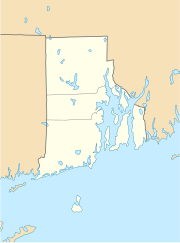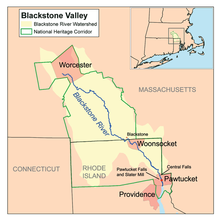Woonsocket (Rhode Island)
| Woonsocket | ||
|---|---|---|
 town hall |
||
| Location in Rhode Island | ||
|
|
||
| Basic data | ||
| Foundation : | 1867 | |
| State : | United States | |
| State : | Rhode Island | |
| County : | Providence County | |
| Coordinates : | 42 ° 0 ′ N , 71 ° 31 ′ W | |
| Time zone : | Eastern ( UTC − 5 / −4 ) | |
| Residents : | 41,186 (as of 2010) | |
| Population density : | 2,059.3 inhabitants per km 2 | |
| Area : | 20.62 km 2 (approx. 8 mi 2 ) of which 20 km 2 (approx. 8 mi 2 ) are land |
|
| Height : | 56 m | |
| Postal code : | 02895 | |
| Area code : | +1 401 | |
| FIPS : | 44-80780 | |
| GNIS ID : | 1219339 | |
| Website : | www.ci.woonsocket.ri.us | |
| Mayor : | Susan D. Menard | |
 Map of Rhode Island |
||
Woonsocket is a US city in Providence County , Rhode Island . Located just south of the Massachusetts border, Woonsocket is the state's sixth largest city according to the 2010 census .
Around 46 percent of Woonsocket's population are French or French-Canadian origins. It is one of the largest French-Canadian cities in New England and is called " La ville la plus française aux États-Unis " (" The most French city in the United States "). For more than a century, French was the city's official language.
history
Before colonization by immigrants lived in the northern Rhode Iceland, the Indian strains of Nipmuck , the Wampanoag and Narragansett . In 1660 Roger Williams bought the region around Woonsocket from them. “Richard Arnold”, a business partner of Williams, then built the first sawmill on the Blackstone River below the “Woonsocket Falls” in the area of today's “Market Square”. "Elizabeth Comstock", Arnold's sister, was one of the first European immigrants to the region and settled in what is now "North Smithfield".
In the early 19th century , the Industrial Revolution began in the United States and Rhode Island was one of the leading states of industrialization. In 1810 the first cotton mill was built, powered by water from the Blackstone River. Over time, the city developed into a center for cotton processing . The technical knowledge brought in French engineers who had immigrated from Roubaix . As a result of immigration, six new villages were created, which were built on the areas of old settlements: "Social Village", "Jenckesville", "Hamlet Village", "Bernon", "Globe Village" and "Woonsocket Falls". In 1834 the "Saint-Jean-Baptiste Society" was founded in Woonsocket, to which June 24th can be traced back as a holiday in Québec .
By the end of the 19th century, countless French Canadians moved to the six villages, which gradually grew together to form "Woonsocket". The originally largest of the six villages - "Woonsocket Falls" - now forms Woonsocket's city center.
As early as the 1920s, the textile industry migrated to southern states and in 1927 the oldest producer, "the Social Mill", had to close. During the Great Depression in the 1930s, up to 50 percent of the population were unemployed and other factories such as the "Globe Mills" were closed. The production of textiles for the military during World War II led to a small economic boom, but after the war ended New England sank into insignificance. The city was forced to diversify its economic base. Today Woonsocket is the urban center of northern Rhode Island. In addition to the manufacturing industry, companies from the fields of high technology and financial services , retail and tourism form the economic backbone of the city.
On the northern outskirts and on the southern main street there is a large number of historic houses that have been included in the " National Register of Historic Places ". Some of the oldest structures, such as the courthouse on the "Street Bridge", had to be demolished and replaced for security reasons.
Blizzard 1978
During a blizzard in 1978, Woonsocket was buried under a meter (39 inches ) of snow . A high pressure area blocked the storm, which therefore moved very slowly. As a result, there were snowfalls of up to ten centimeters per hour, which were accompanied by lightning and thunder. To assist the city in efforts to enable people to lead normal lives under these circumstances, the State of Rhode Island alerted the National Guard . Woonsocket itself published a snow depth of 1.37 meters, but these measurements were based on an area with heavy snowdrifts . It was assumed that the mayor at the time, "Gerard Bouley", had deliberately published the maximum snow depth in order to allow the city to receive more money from a disaster fund. As a result, this snow depth is humorously referred to as "Gerry's Total".
Meaning and origin of the name
In a letter to Richard Arnold, Roger Williams called the area that he bought from the Indians in 1661 " Niswosakit ". In the native language, Woonsocket means “ thunder mist ”. The name could refer to the largest waterfall of the Blackstone River, the "Woonsocket Falls", which are located in the center of the city. Other interpretations of the meaning of the name assume that the city was named after "Woonsocket Hill" in neighboring "North Smithfield". The old settlement names of the Nipmuck Indians near Massachusetts, which sound similar to Woonsocket, are also possible sources: "Woonksechocksett" in Worcester County means something like " The land of the fox " and "Wannashowatuckqut" also in Worcester County was " lying in the fork of the river ".
Autumnfest
Since 1977 there has been an autumn festival on the weekend of Columbus Day in the "World War II Veteran's Memorial State Park". It is run by the Woonsocket Rotary Club and supported by sponsors such as CVS Caremark Corporation . The festival aims to bring the culture and history of Woonsocket to the people of Rhode Island and Massachusetts.
The “Autumnfest” traditionally begins on Saturday at 10:00 am with an opening speech by the mayor at the “park's band stand”. The three-hour Columbus Day Parade, one of the largest parades in the state, begins the following Monday at 9:00 am. On the same day at 6 p.m. the festival ends with the award ceremony of a local Ironman competition and a large fireworks display. Over the course of three decades, the festival has become a well-known Rhode Island attraction.
Personalities
- Bryan Berard (* 1977), ice hockey defender
- Brian Boucher (* 1977), ice hockey goalkeeper
- James Edwin Cassidy (1869–1951), Catholic clergyman, Bishop of Fall River
- Dave McKenna (1930-2008), jazz pianist
- Duke Robillard (* 1948), blues singer and guitarist
- Edwin O'Connor (1918–1968), Pulitzer Prize winner ( The Edge of Sadness, 1962)
- J. Howard McGrath (1903-1966), was Governor of Rhode Island , US Senator and Attorney General
Demographic data
| Age group | Percentage |
|---|---|
| under 5 | 7.6 |
| under 18 | 24.0 |
| 65 years and older | 13.2 |
According to a census in 2010, Woonsocket had 41,188 inhabitants in 16,602 private households . The largest ethnic group in the city was made up of around 77.7 percent of residents of European descent. Children under the age of 18 lived in around 24 percent of all households.
The median annual income per household was $ 38,625. After all, 22.2 percent of families lived below the poverty line .
Web links
- Official website , English
Individual evidence
- ↑ a b Census: "Woonsocket (city), Rhode Island" ( Memento from January 20, 2013 in the Internet Archive ).
- ↑ a b c Woonsocket - History
- ↑ Walter Nebiker. The History of North Smithfield , New England History Press: Somersworth, NH: 1976, 12-13.
- ^ Mills along Main Street
- ^ Water Power
- ^ Woonsocket's Original Mill Villages
- ^ Saint-Jean-Baptiste Society
- ^ Valley Sites - Woonsocket, Blackstone , nps.gov
- ^ Depot Square
- ↑ The Blizzard of 1978, The origin of Rhode Island's bread and milk mania
- ^ Walter Nebiker: The History of North Smithfield , New England History Press, Somersworth, 1976, p. 12-13
- ^ The "Woonsocket Falls" on google Maps
- ^ Nipmuc place names of New England , native tach.org
- ↑ Autumnfest

